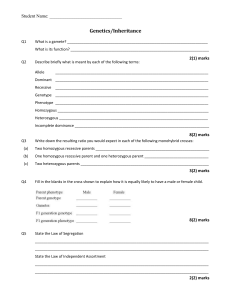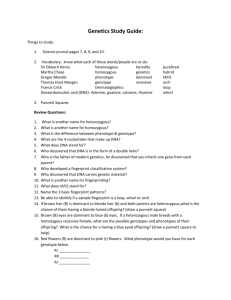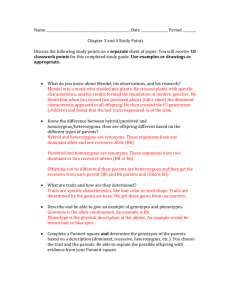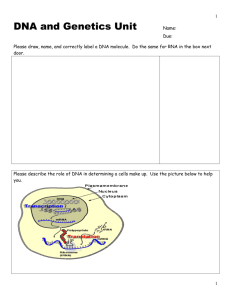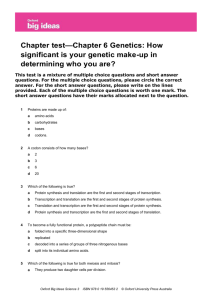Chaptest_chapter4
advertisement
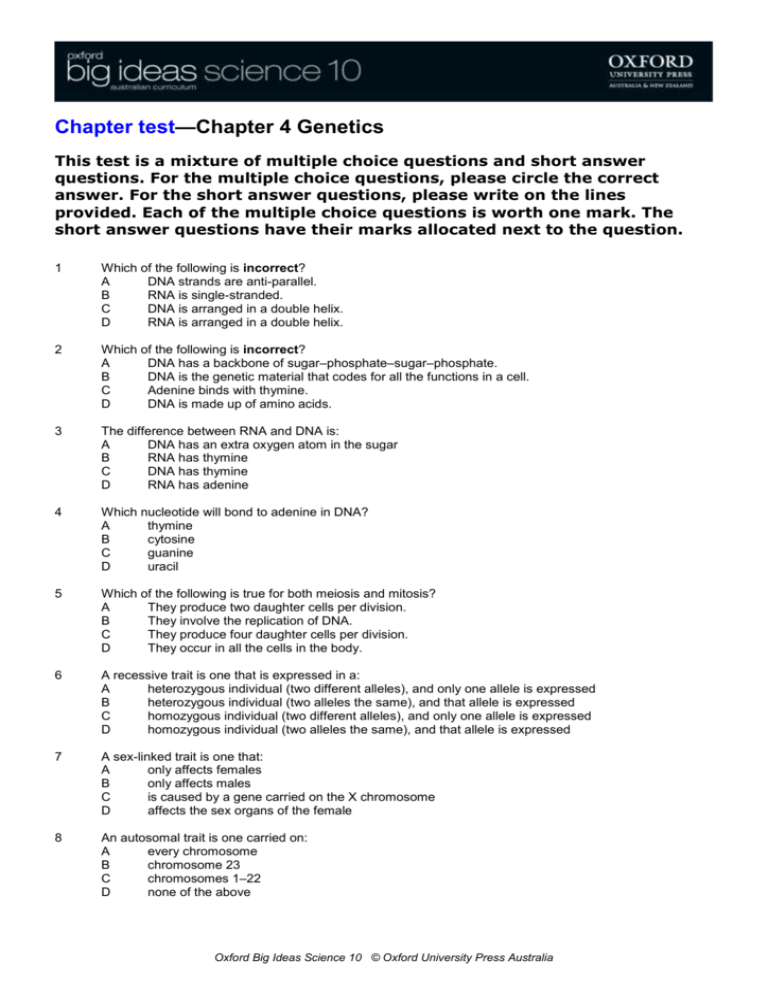
Chapter test—Chapter 4 Genetics This test is a mixture of multiple choice questions and short answer questions. For the multiple choice questions, please circle the correct answer. For the short answer questions, please write on the lines provided. Each of the multiple choice questions is worth one mark. The short answer questions have their marks allocated next to the question. 1 Which of the following is incorrect? A DNA strands are anti-parallel. B RNA is single-stranded. C DNA is arranged in a double helix. D RNA is arranged in a double helix. 2 Which of the following is incorrect? A DNA has a backbone of sugar–phosphate–sugar–phosphate. B DNA is the genetic material that codes for all the functions in a cell. C Adenine binds with thymine. D DNA is made up of amino acids. 3 The difference between RNA and DNA is: A DNA has an extra oxygen atom in the sugar B RNA has thymine C DNA has thymine D RNA has adenine 4 Which nucleotide will bond to adenine in DNA? A thymine B cytosine C guanine D uracil 5 Which of the following is true for both meiosis and mitosis? A They produce two daughter cells per division. B They involve the replication of DNA. C They produce four daughter cells per division. D They occur in all the cells in the body. 6 A recessive trait is one that is expressed in a: A heterozygous individual (two different alleles), and only one allele is expressed B heterozygous individual (two alleles the same), and that allele is expressed C homozygous individual (two different alleles), and only one allele is expressed D homozygous individual (two alleles the same), and that allele is expressed 7 A sex-linked trait is one that: A only affects females B only affects males C is caused by a gene carried on the X chromosome D affects the sex organs of the female 8 An autosomal trait is one carried on: A every chromosome B chromosome 23 C chromosomes 1–22 D none of the above Oxford Big Ideas Science 10 © Oxford University Press Australia 9 Let us say that the gene that codes for normal-type wings in fruit flies has the symbol N and the gene that codes for vestigial (stunted) wings has the symbol n. The phenotype of heterozygous flies would be: A Nn B normal wings C vestigial wings D NN 10 Let us say that the gene that codes for normal-type wings in fruit flies has the symbol ‘N’ and the gene that codes for vestigial (stunted) wings has the symbol ‘n’. The genotype of vestigial wing flies would be: A Nn B NN C nN D nn 11 In a cross between two homozygous dominant individuals, the chance of a heterozygous child is: A 0% B 50% C 75% D 100% 12 In the following pedigree, the trait shown by the affected individuals would be: A B C D 13 recessive dominant either recessive or dominant neither recessive or dominant The genotypes and phenotypes of the ABO blood group are as follows: Genotype IAIA IAi IAIB IBIB IBi ii Phenotype A A AB B B O A female with blood group AB and a male with blood group O have a child. The child is: A most likely to have blood group A B most likely to have blood group O C most likely to have blood group B D equally likely to have blood group B or blood group A 14 In rabbits, normal colour (C) is dominant to albino (c). A boy crossed a normal rabbit that has one albino gene with an albino rabbit. The offspring would be expected to be: A all normal colour B all albino C 75% normal colour and 25% albino D 50% normal colour and 50% albino Oxford Big Ideas Science 10 © Oxford University Press Australia 15 How many different phenotype are in the following Punnett square? P1 N n N NN Nn n Nn nn P2 A B C D 2 3 4 8 16 Two heterozygous individuals are bred. The next generation is expected to be: A all homozygous recessive B all heterozygous C 50% homozygous recessive and 50% homozygous dominant D 25% homozygous recessive, 50% heterozygous and 25% homozygous dominant 17 Which of the following is correct? A Males have two X chromosomes and females have an X and a Y chromosome. B Females have two X chromosomes and males have an X and a Y chromosome. C Males have two Y chromosomes and females have an X and a Y chromosome. D Females have two X chromosomes and males have two Y chromosomes. 18 Detecting the genes for cystic fibrosis in a newborn baby is an example of: A gene therapy B nuclear transfer C genetic testing D DNA profiling 19 The type of cells that might be used in the future to treat diseases such as cancer and multiple sclerosis, and spinal cord injuries, are: A embryonic stem cells B adult stem cells C nerve cells D all of the above 20 Plants that have been modified in the laboratory to enhance desired traits are known as: A embryonic stem cells B adult stem cells C genetically modified organisms D transgenic organisms 21 What does DNA stand for? (1 mark) Oxford Big Ideas Science 10 © Oxford University Press Australia 22 Draw a strand of DNA, showing the double helix and at least four complementary pairs. (3 marks) 23 What is the difference between DNA and RNA? (1 mark) 24 What is a genetically modified plant? (1 mark) 25 This diagram shows the stages involved in one type of cell division. a Which type of cell division is shown in this diagram? Give a reason for your answer. (2 marks) b Give an example of a human cell that would undergo this type of cell division. (1 mark) Oxford Big Ideas Science 10 © Oxford University Press Australia 26 In the table below, write three ways in which mitosis differs from meiosis. (3 marks) Mitosis 27 28 29 Meiosis a Which type of cell division is involved in growth and cell replacement? (1 mark) b Which type of cell division produces sex cells? (1 mark) A baby koala has 16 chromosomes in each body cell. a What is the diploid number of a koala? (1 mark) b How many autosomes would the koala have in a body cell? (1 mark) c What is the haploid number of a koala? (1 mark) d How many chromosomes did the koala receive from each parent? (1 mark) e How many autosomes would the koala have in a sex cell? (1 mark) What two factors affect the phenotype of an organism? (2 marks) Oxford Big Ideas Science 10 © Oxford University Press Australia 30 Using examples, explain the following terms: a alleles (2 marks) b homozygous (2 marks) 31 ‘A dominant trait is one that is expressed by a greater percentage of the population and a recessive trait is one that is expressed by a very small percentage of the population.’ Is this statement true or false? Give reasons for your answer. (3 marks) 32 Give three practical applications of genetic engineering. (3 marks) 33 What are the two types of genetic mutation? What is the difference between them? (4 marks) Oxford Big Ideas Science 10 © Oxford University Press Australia 34 What are GMOs? Why is there debate about whether we should use them? Give two examples of ethical concerns with regard to GMOs. (4 marks) 35 How can privacy be an issue with regards to genetic screening? (2 marks) 36 Mendel discovered that in pea plants the green pea pod is dominant over the yellow pea pod. Using G to represent the allele for green pea pods and g to represent the allele for yellow pea pods: a write the genotype for a homozygous plant with yellow pea pods (1 mark) b write the genotype for a heterozygous plant (1 mark) c complete the Punnett square to represent the cross of two heterozygous plants. (2 marks) P1 G g P2 G G Oxford Big Ideas Science 10 © Oxford University Press Australia 37 In a particular breed of dog, the allele for erect ears (E) is dominant and drooping ears (e) is recessive. A droopy-eared bitch (female) is mated with an erect-eared dog. They have 2 female and 2 male offspring, 2 of which have the erect ears trait. Draw a pedigree chart for the dominant trait. (4 marks) 38 a What is a mutation? (1 mark) b What is a mutagen? (2 marks) 39 How can a mutation be beneficial to a population? (2 marks) 40 Suppose you could clone your pet guinea pig. Would the clone be identical to your pet? Explain your answer. (2 marks) Oxford Big Ideas Science 10 © Oxford University Press Australia
